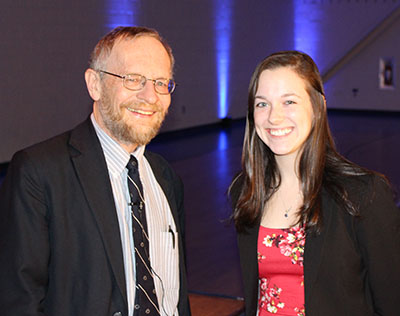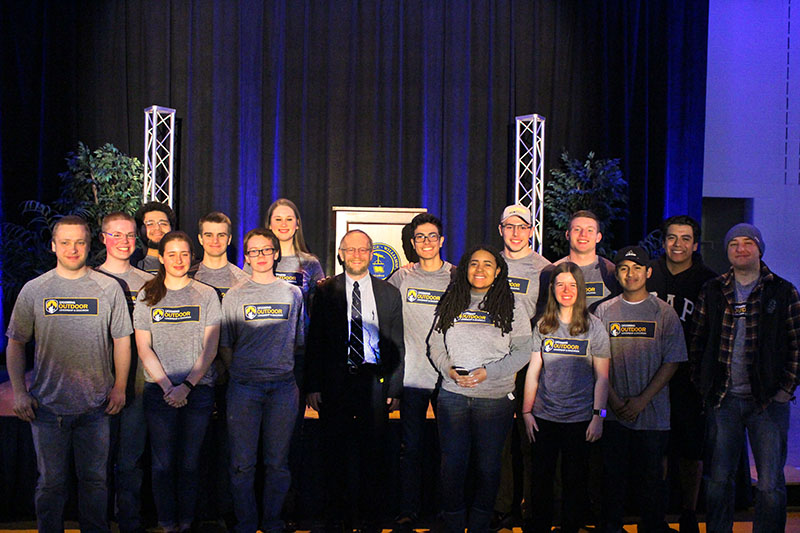
Dr. Richard Alley and Julie Burns, a senior ecology major who introduced Alley to the audience.
Download Image: Web
The average American eats about 2,000 calories per day, creating the equivalent of about 100 watts of energy. Each American uses more than 10,000 watts of energy in heating, cooling, lighting, and other beneficial energy use. Currently, 83 percent of that energy usage is created by fossil fuels.
Richard Alley, Ph.D., the Evan Pugh Professor of Geosciences and Associate of the Earth and Environmental Systems Institute at The Pennsylvania State University, used those statistics to introduce his presentation at Lycoming College on March 22. His presentation, titled “The big picture on energy and climate,” discussed the dynamics between money, jobs, national security, ethics and the environment, and how those forces influence perceptions and decisions about energy.
Alley’s presentation strikes a balance between understanding the importance of energy to a thriving society and the need to address climate change caused by the use of fossil fuels, which will eventually run out.
Alley presented a brief history of energy sources starting with the use of lumber and whale oil. When these resources began to run out, demand for coal and oil increased. Unlike trees and whale populations that can replenish in 100 years, fossil fuels require millions of years to form.
“So we must learn while we burn, or burn then learn. Regardless of how long we use them, [fossil fuels] will run out,” Alley said. Through the burning of fossil fuels, the average American releases about 19 tons of carbon dioxide into the air every year, which affects the climate. He highlighted the need to tap renewables, such as wind and solar, which are limitless sources of energy and do not release carbon dioxide into the atmosphere.
Addressing climate change skeptics, Alley showed the basis for understanding the realities of global warming is based on physics, observation, climate models and history.
For about a century, scientists have known about the insulating effect of the atmosphere, first introduced by Joseph Fourier about 1829, and the warming role of carbon dioxide, established by John Tyndell in 1859. Over the past century, thermometers in all parts of the world are showing a pattern of increasingly higher temperatures. The warming effects of carbon dioxide was observed by the U.S. Air Force during World War II. More recently, satellite images from around the world document less snow and ice and computer models have shown they can reliably predict climate changes.
“To make science useful, we must solve the equations for issues we care about,” Alley said. “If you put the earth into computer models using what we know about physics, you get global warming. If you then pretend carbon dioxide doesn’t warm, you will see the models create an Earth that freezes over into a giant snowball. There’s just no honest way for the physics to work without acknowledging the warming aspect of carbon dioxide.”
Alley acknowledged that temperatures fluctuate over the years, but they clearly have been and are continuing to trend upward since the turn of the century. Despite what skeptics say, the majority of scientists agree on this point, he said.
“You have to look at the temperatures over a long period of time. Skeptics tend to focus on only several years at a time, which show little movement in average temperatures,” said Alley. “That [focus on a narrow time frame] allows legislators and industry to deflect the need for real change.”
Alley recognized that nature produces carbon dioxide on its own, but stated humans create about twice as much carbon dioxide as natural sources. “If we don’t restrain carbon dioxide, the coming changes are bigger than they have been in the past. The costs will rise faster and the changes will create global winners and losers.”
Another issue related to climate change is the documented increase of human conflict with increases in temperatures. Social scientists have documented that as heat increases, so do shootings, rapes and social media shouting. They also noted that test scores go down. Sociologists have theorized that the increased drought conditions in Syria added stressors to that contributed to the conflict in that country. Because of this phenomenon, Alley notes that leaders of U.S. armed forces perceive climate change as a national security threat because the U.S. is called to help with military issues around the world.
“When our students are old, our average temperatures will be hotter than our highest temperatures are now,” Alley said. “If we don’t change what we are doing, the world will lose about 40 percent of its ability to work outside. By late in the century, computer models predict that there will be areas in the world where it will be too hot to survive.”
Alley promotes turning to solar and wind energy sources because they are sustainable and have less environmental impact. He noted the economic potential of renewable energy sources with creating jobs — America already has twice as many solar workers as coal miners — and improving national security and the environment. He also noted conservation is an important aspect of the country’s approach to energy. Highlighting what’s possible, he showed that recent carbon dioxide levels have flattened while the economy has grown.
He encouraged people to get involved. “Surveys show that people believe there are solutions, but that no one is talking about them. If we speak with others in a respectful way, we can change our approach. We can build a better market. We can make money, and make the world better. We know how to fix this in a way that lasts a long time,” Alley said.
“Can we have a world with icebergs and rainbows? Yes we can,” he said.
For interesting statistics used during Alley’s presentation, see climatecommunication.yale.edu/visualizations-data/.

Richard Alley with student leaders for Lycoming College’s Outdoor Leadership and Education program.